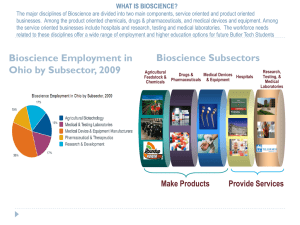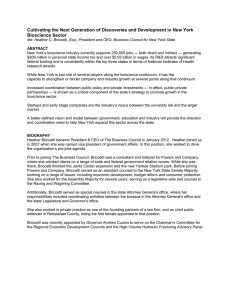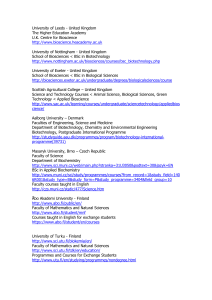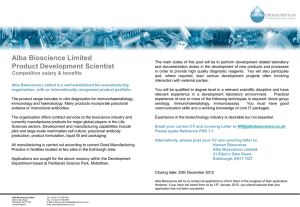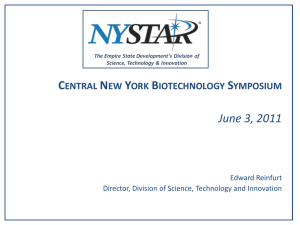Industry Insights into Biotechnology
advertisement
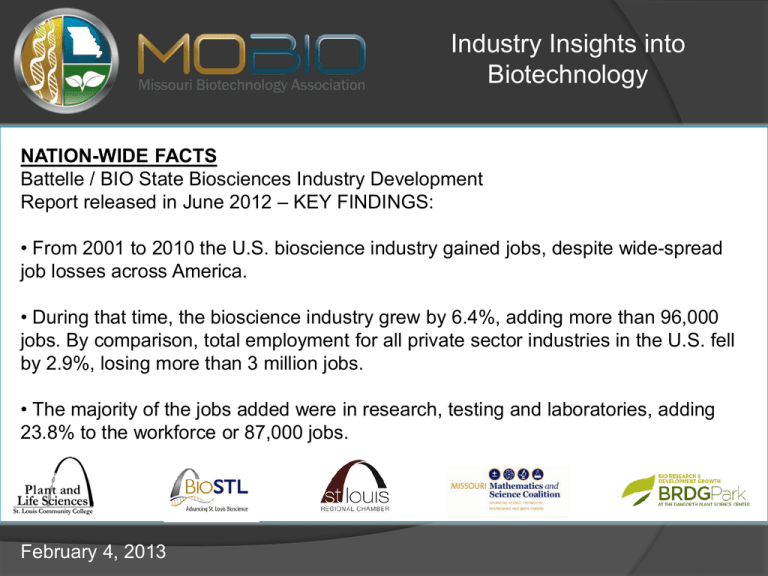
Industry Insights into Biotechnology NATION-WIDE FACTS Battelle / BIO State Biosciences Industry Development Report released in June 2012 – KEY FINDINGS: • From 2001 to 2010 the U.S. bioscience industry gained jobs, despite wide-spread job losses across America. • During that time, the bioscience industry grew by 6.4%, adding more than 96,000 jobs. By comparison, total employment for all private sector industries in the U.S. fell by 2.9%, losing more than 3 million jobs. • The majority of the jobs added were in research, testing and laboratories, adding 23.8% to the workforce or 87,000 jobs. February 4, 2013 Industry Insights into Biotechnology • The U.S. bioscience industry weathered the recession much better than the overall economy and other leading knowledge-based industries. While national private sector employment fell by 6.9% from the outset of the recession in 2007 through the first year of the recovery in 2010, bioscience industry employment fell a mere 1.4%. • The strength of the bioscience industry is seen when compared to other leading knowledge-based industries, such as information technology services, aerospace, computer equipment and finance and insurance, all of which recorded net job losses during the same period. • The bioscience sector continues to be a source of high-wage jobs. The average bioscience job paid $82,697 in 2010, $36,000 more than the average private sector job. February 4, 2013 Industry Insights into Biotechnology STATE FACTS • Employment: 27,180 - Direct-Effect Employment Multiplier: 3.4 - Total Employment Impact: 93,242 • Average Annual Wage: $69,853 State Establishments Employment Multiplier Total Employment Impact Average Annual Wage Missouri 1,309 27,180 3.4 93,242 $69,853 Kansas 761 13,266 2.2 29,684 $69,127 Illinois 3,424 79,961 4.3 347,006 $92,803 Iowa 1,250 23, 729 2.9 68,116 $64,103 February 4, 2013 Industry Insights into Biotechnology Midwest Employment Trends – Animal & Plant Sciences Sector • Missouri ranks second behind Illinois in Animal and Plant Sciences sector employment within the Midwest with 15% of the cluster’s total non-farm employment in the nine-state area. Employment density is highest in the metro areas of St. Louis, Kansas City, St. Joseph, Columbia, Springfield, and Joplin. The regional map highlights the areas of heavy employment density for the Animal and Plant Sciences cluster. • The Missouri public and private sector employment trend from 2006-2010 showed a modest increase, with employment gains of 4%. Illinois, with over a third of the region’s employment in this sector, showed a job loss of -6.4%. Kansas had the highest percentage gain from 20062010, with 19.4%. Illinois was the only state to experience job loss in this sector. The Midwest over-the-year employment trend held steady with an estimated +1.8% increase. Regional February 4, 2013 Industry Insights into Biotechnology Midwest Employment Trends – Biomedical Sector • Missouri ranks third behind Illinois and Tennessee in Biomedical sector employment within the Midwest with nearly 15% of the cluster’s total non-farm employment in the nine-state area. Employment density is highest in the metro areas of St. Louis, Kansas City, Columbia, and Cape Girardeau. The regional map highlights the areas of heavy employment density for the Biomedical cluster. • Missouri public and private sector employment trends from 2006-2010 are down -9.3% for this cluster. Illinois, with over a third of the region’s employment in this sector, showed modest job gains of 0.8%. Tennessee had the highest percentage gain from 2006-2010, with 25.7%. Five of the states experienced losses in this sector. The Midwest over-the-year trend held steady with an estimated +0.9% increase. February 4, 2013 Industry Insights into Biotechnology Employment Growth • MO specialization and employment growth was most prominent in the Agricultural Feedstock & Chemicals subsector 2007-2012 • Despite national declines in the agbiosciences subsector, MO has added jobs since 2007 February 4, 2013 Industry Insights into Biotechnology Ways to prepare students for the workplace in our industry: • Industry involvement is absolutely essential. • A broad and diverse range of students must be trained. • Challenges in developing curricula for bioscience workforce and career development. • Difficulties in experiential learning and internships are real. • Lack of statewide coordination wastes resources. February 4, 2013 Industry Insights into Biotechnology There are four primary strategies that states can employ to retain the industry and grow the size and diversity of all four industry sectors all across the states: • Building career pathways for future biosciences talent with constrained budgets. • Address the overall supportive regulatory climate in your state to ensure predictable and stable regulatory treatment of biosciences firms • Encourage universities and research centers to continue efforts in technology transfer. • Utilize state dollars for technology-based economic development There are a number of legislative avenues that the bioscience can tap into to support early-stage companies and the entrepreneurs who manage them by: - Creating a BioEntrepreneur Resource Program that helps connect biotech startups with early-stage capital. - Supporting a permanent state research and development tax credit, targeting it to companies with fewer than 50 employees. - Legislating an Investor Tax Credit to spur more early-stage investment in bioscience companies. - Seeding a Bioscience Product Development Loan Fund to bridge the funding gap for companies going from startup to product launch phases. February 4, 2013
